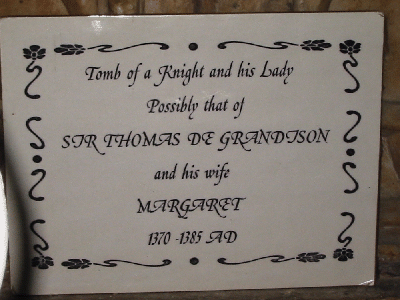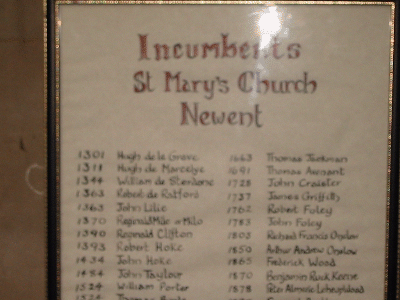| Anglican Church of St Mary the Virgin, Newent, Gloucestershire, England
The 14th Century Tower entry welcomes all comers, with reminders that this has been a place of worship for many generations. Two massive stone slabs propped against the West wall are thought to be of 7th century Celtic workmanship. In front is a portion of the shaft of a cross with carving of a Northumbrian type dated perhaps in the 9th century. The roof is supported by an impressive pillar. On the night of Sunday 18 Jan 1674 the original nave collapsed under a heavy weight of snow. A sum of ten shillings was afterwards left to the Parish to endow an annual sermon in thanksgiving for the escape of the congregation which had assembled there twelve hours earlier. The Nave is now spanned by a splendid roof measuring 75 feet by 50 feet, for which King Charles II gave sixty tons of oak from the Royal Forest of Dean. It was completed in 1679. The East end of the church is divided into three parts, the medieval chancel, the Sanctury and the Lady Chapel, formerly a chantry chapel dedicated to the Blessed Virgin Mary. One headstone is to Richard Warjohn who was a member of the choir for 77 years, and died in 1834. A brass in the Lady Chapel is inscribed for Roger Porter who died 15 April 1523 and in his Will said 'For my tithes forgotten I will that two oxen be eaten amongst my neighbours at my burying with bread and ale accordingly.'
|
 An English tomb An English tombThe arches between the chancel and the Lady Chapel are the oldest features of the present church, and span this alabaster tomb with recumbent effigies of a Knight and his lady, dated 1370-85 from the style of dress. The 'studded' armour is found on only 8 effigies in England. The effigies were broken into pieces sometime between 1780 when Bigland wrote his 'History of Gloucestershire' and 1860 when they were repaired (but still lack their arms).
|
 There is a tradition that the knight was a mamber of the Grandison family, who were landowners in the Newent district. Sir Thomas de Grandison died in 1375 and his wife Margaret died about 1394. The shields on the panels of the tomb have lost all signs of colouring, one still has a faint relief of a lion or possibly a dragon rampant.
There is a tradition that the knight was a mamber of the Grandison family, who were landowners in the Newent district. Sir Thomas de Grandison died in 1375 and his wife Margaret died about 1394. The shields on the panels of the tomb have lost all signs of colouring, one still has a faint relief of a lion or possibly a dragon rampant.
|
 The list has been checked against the surviving published Registers of the Bishops of Hereford and Gloucester Diocesan records, and begins with Hugh de la Grave installed in 1301.
The list has been checked against the surviving published Registers of the Bishops of Hereford and Gloucester Diocesan records, and begins with Hugh de la Grave installed in 1301.Second is Hugh de Marcelye who, in March 1312 was licensed to travel to the Papal Court of Rome on business of the church - a slow journey in those days. The earliest surviving parish registers start in 1673, when King Charles II was restored. Newent was in Hereford Diocese until 1541 when the Diocese of Gloucester was created. The advowson or patronage of the living went with the lordship of the manor which belonged to the Abbey of Cornelius in Normandy from before 1087 (the Domesday Survey) till the wars with France when the Priory of Newent was among those seized by King Edward III as enemy property and about 1700 was sold to the Foley family (Vicars 1762 to 1803). Eventually it was presented to the Bishop of Gloucester in 1962 by Trinity College Dublin who were bequeathed it by the Rev CJK Burnell, rector 1925 - 49.
|
 The Nave was rebuilt by 1679 by Edward Taylor of Newent, who had worked in London with Sir Christopher Wren. Preaching was the most important part of public worship. and the whole church was oriented from the altar and towards the pulpit on the north wall. Later ideas around 1890 included lowering the old box-pews and removing their doors, and installing heating stoves for the first time. Electric light was installed in 1931.
The Nave was rebuilt by 1679 by Edward Taylor of Newent, who had worked in London with Sir Christopher Wren. Preaching was the most important part of public worship. and the whole church was oriented from the altar and towards the pulpit on the north wall. Later ideas around 1890 included lowering the old box-pews and removing their doors, and installing heating stoves for the first time. Electric light was installed in 1931.
The oldest bell is dated 1638, when Charles I was King of England, just prior to the Civil War. In 1983 two new trebles were added to the ring of six dated 1843, 1674, 1638, 1909, 1724 recast 1899, and 1850. |
Return to my Trip Page. |
 First visited on a wet day, Friday 2nd May, 2003.
First visited on a wet day, Friday 2nd May, 2003.